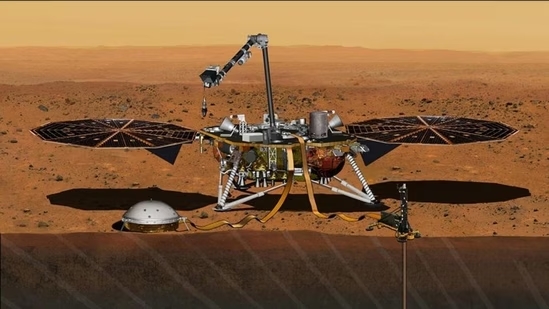Recent seismic data from NASA’s InSight lander has unveiled a remarkable finding: a substantial reservoir of liquid water may lie deep beneath the Martian surface. While previous research has confirmed the existence of frozen water at the poles of Mars and detected water vapor in its atmosphere, this discovery represents the first direct evidence of liquid water on the planet.
Professor Michael Manga from the University of California, Berkeley, discussed the significance of this discovery with the BBC, stating that water is a fundamental molecule in determining a planet’s evolutionary trajectory. This revelation addresses a longstanding question about the fate of Mars’ water, shedding light on the historical mystery of where all the Martian water went.
Previous studies have uncovered signs of ancient rivers and lakes on Mars, such as water channels and ripples in the planet’s surface. These findings indicate that Mars once had liquid water flowing across its surface. However, the planet has been a desolate desert for approximately three billion years. This transformation occurred after Mars lost its atmosphere, which acted as a protective shield, allowing water and other vital molecules to be stripped away by the sun.

Professor Manga drew a parallel between Mars and Earth, noting that a significant portion of Earth’s water is stored underground. Given Mars’ similarities to Earth, often referred to as its twin, it is plausible that Mars could have a comparable reservoir of subsurface water.
The discovery of liquid water on Mars is particularly exciting because it opens up the possibility of finding habitable environments beneath the surface. Since water is essential for life as we know it, the presence of liquid water raises intriguing prospects for the potential existence of life on Mars.
Understanding the water cycle on Mars is crucial for gaining insights into the planet’s climate evolution, surface conditions, and internal structure. This research will contribute to our knowledge of how Mars has transformed over time and how its environment could potentially support life.
NASA’s InSight mission officially concluded in December 2022. However, the lander will continue to gather seismic data from Mars’ surface for an additional four years. Since its deployment, InSight has detected nearly 1,319 seismic events. By analyzing the velocity of seismic waves traveling through Mars, scientists have been able to infer the composition of materials beneath the surface. These findings have been detailed in a recent publication in the Proceedings of the National Academy of Sciences.
The methods used by InSight to detect and analyze seismic waves are similar to those employed on Earth for water exploration and the search for oil and gas. This innovative approach allows scientists to explore and understand the subsurface characteristics of Mars in unprecedented detail.



 Viesearch - The Human-curated Search Engine
Blogarama - Blog Directory
Web Directory gma
Directory Master
http://tech.ellysdirectory.com
8e3055d3-6131-49a1-9717-82ccecc4bb7a
Viesearch - The Human-curated Search Engine
Blogarama - Blog Directory
Web Directory gma
Directory Master
http://tech.ellysdirectory.com
8e3055d3-6131-49a1-9717-82ccecc4bb7a